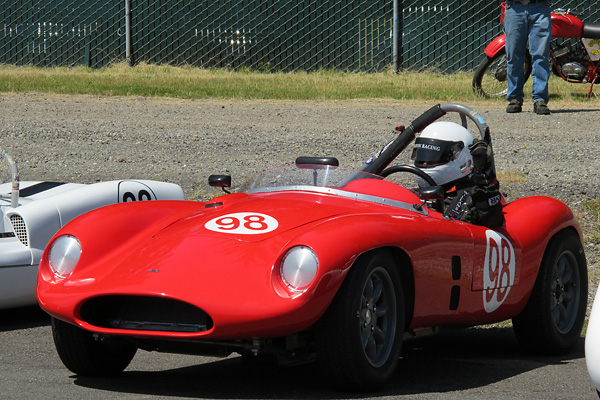
Bill Hart's 1957 Devin Bodied Triumph Vintage Race Car
Owner: Bill HartCity: Seattle, Washington
Chassis: 1953 Triumph TR3, with 1957 Devin body
Engine: Triumph TR3 engine
Race prepared by: Tony Garmey
Devin Bodies Suited Popular British Sportscars
Devin Enterprises Inc. is widely remembered as one of the earliest and most successful
manufacturers of fiberglass kit-car bodies. Devin bodies were installed over all sorts of
chassis, and powered by all sorts of engines. Devin-bodied British sports cars - specifically
Triumph, MG, and Austin-Healey specials - were well represented in the North American
racing scene of the 1960s.
Proprietor Bill Devin (1915-2000) had grown up in Oklahoma around his father's Chevrolet
car dealership. After wartime service as a Machinist's Mate in the Navy, Devin set himself
up in business with one Chrysler-Plymouth agency and then another, but he and his brother
Gene were drawn to European sports cars and to the Southern California racing scene of the
early fifties. It wasn't long before Devin was wheeling and dealing in Siata and Ferrari
sports cars. However, he found that the European companies on the whole seemed to have a
disdain for their American customers. He aspired to build sportscars in California.
Devin's initial offering was a rather odd little creation known as a Devin Panhard. These
were lightweight front-wheel-drive cars powered by 750-850cc air-cooled two-cylinder engines
with uniquely belt-driven overhead cams. (Bill Devin was very proud of that innovation.)
Sold for $995 in kit form or $2850 complete, around twelve were built. Bill's friend
Jim Orr raced a Devin-Panhard in 24 SCCA races to win SCCA's 1956 H-Modified Class
National Championship.
Devin set up to produce fiberglass car bodies in El Monte, California. Production spanned
from about 1955 into 1964. Through that decade, Devin advertisements appeared in all the
popular American sports car magazines. Completed Devin projects were the subjects of feature
articles. The company produced complete cars too - three basic models - but only in
very modest volumes. By the standards of their day, styling and fiberglass production quality
were considered top-notch yet pricing was remarkably affordable.
Who styled those beautiful Devin bodies? Bill Devin stole the design from Scaglietti.
Specifically, Bill Devin borrowed an Italian-made 1955 Ermini Tipo 357 Sport (body by Scaglietti,
1100cc engine) from his friend Jim Orr and used it as a "plug" to create the Devin body molds.
His genius was in adaptation. He figured out how to cut here and extend there, until he had
a set of over fifty molds with which he could create just about any sized sportscar body his
customers might desire.
Early Devin magazine ads offered bodies for "Crosley, Healey, TR, MG, Fiat, Hillman,
Volkswagen, Morris and many other light car chassis..." Initially, Devin fiberglass bodies
were offered "ready-to-mount" in twenty-four different track and wheelbase combinations.
That number later expanded to twenty-seven to suit longer (typically American) chassis
designs.¹ Regardless of size, all twenty-seven models were priced the same at just $295.
A limited range of non-fiberglass parts were offered: hinges, door catches, steering wheels,
Stewart Warner gauges, Borrani wire wheels, and eventually a special deDion assembly configured
to work with a Chevrolet Positraction differential.
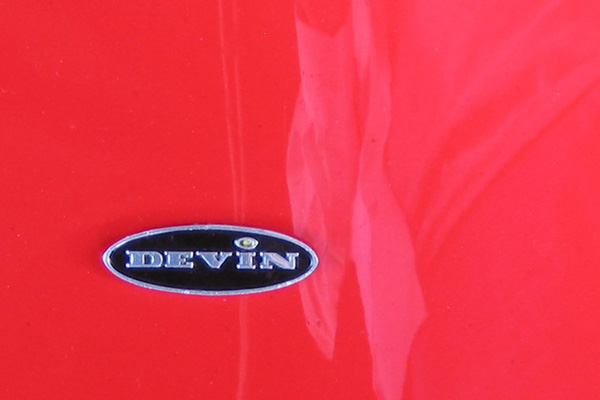
Devin Enterprises Inc. bonnet emblem.
In addition to bodies, Devin also offered complete kits. Some of Devin's early ads noted that
$995 would purchase a fiberglass body, a tube-frame chassis, axles, and suspension.
As you might expect, the content of these kits was negotiable and extremely variable.
Bill Devin made initial plans for an "SS" model kit car in 1956. It would have used 1940s
Ford and Lincoln components (including a narrowed solid front axle) but powered by a Chevrolet
Corvette 283cid V8 engine. The SS concept changed dramatically based on conversations with a
customer named Malcolm MacGregor of Belfast, Ireland. The reconsidered Devin SS would be a premium
sportscar, using lighter weight British components (e.g. Girling brakes), and Bill Devin's new
target was to sell 150 fully-assembled cars to meet FIA homologation requirements.
Only fifteen cars were actually completed, in a production run that started in 1958 and carried
into 1961. Devin had contracted with Devonshire Engineering in Ireland to produce the SS's tube frame,
without anticipating various logistical problems which increased his costs. An initial price of $5950
had been announced in magazine articles, but had to be increased to over $10,000 during production.
Devin's D model was aimed more realistically, and therefore sold better. Despite using Volkswagen beetle chassis
and drivetrain components, it received generally favorable press attention. The review in Sports Car Graphic's
May 1961 edition was titled "D Stands for Delightful" although the small print included complaints about the
test car's lack of power and its horrible brake equipment. Devin offered the C in kit form, without any VW parts,
for $1495. As a completed car, the price was $2950.
The Devin C model came next. This time, C stood for Corvair. By the end of all production in 1964, Devin
claimed sales of the C and D combined had reached 150 units.
Credible sales records don't exist, but total sales volume of Devin's fiberglass bodies may very
well have reached four digits. It's unlikely more than a quarter of that number were ever mounted.
Bill Hart's Devin Triumph Special
Bill Hart's Devin bodied Triumph was originally built to be a street car.
When Bill Hart acquired it, it still had old license plates on it.
He has been racing it for eleven years now.
Bill recalls that the car started out horribly. It wouldn't go fast, and it wouldn't stop either.
After quite a lot of development, it's turned into a little rocketship. Furthermore, it draws
complements everywhere it races. In his latest book, Kas Kastner describes Bill Hart's Devin bodied
Triumph as follows: "Set up to be ultra reliable, and very quick. Bill enjoys a lot of track time
with this great car. Bill's car has the best body and paint work I have ever seen on a fiberglass
body." High praise indeed, especially considering the source. Bill has received an invitation and
will be taking his Devin Triumph to the Monterey Historics this year.
Features and Specifications
| Engine: | rebuilt and race prepared Triumph TR3 engine, originally 1991cc but now about 2100cc.
89mm bore.
164bhp.
Approximately 11:1 static compression ratio.
Dual Weber 45DCOE carburetors.
Mallory distributor. (two wire)
MSD Blaster ignition coil.
Taylor Spiro Pro 8mm silicone spark plug wires.
Gear reduction starter.
Deep sump finned aluminum oil pan. |
| Cooling: | aluminum crossflow radiator.
Electric cooling fan.
Oil cooler. |
| Exhaust: | custom four into one header.
Stainless steel muffler. |
| Transmission: | Triumph TR3 gearbox, rebuilt with close ratio gears.
Triumph shifter lever, rotated 180 degrees. |
| Rear axle: | Triumph TR3 housing.
Tran-X limited slip differential. |
| Front Susp.: | stock Triumph TR3 Alford & Alder forged uprights.
Custom fabricated control arms modified with Heim joints on outboard side for adjustability.
Stock lower control arms modified with Heim joints on inboard side for adjustability.
KONI telescoping shock absorbers.
Adjustable (5 position) modular anti-sway bar. |
| Rear Susp.: | leaf springs.
Lever shock absorbers.
Adjustable anti-sway bar mounted on aluminum pillow blocks. |
| Brakes: | (master) dual master cylinders with bias bar. (front) Girling aluminum calipers. Solid rotors. (rear) aluminum finned drums. |
| Wheels/Tires: | Compomotive ML 8-spoke aluminum wheels.
Hoosier Vintage T.D. tires (5.00x15 front, 5.50x15 rear). |
| Electrical: | Enersys / Odyssey sealed lead acid battery.
Nippondenso alternator, with oversized pulley. |
| Instruments: | (left to right)
Stewart Warner voltmeter (10-16V),
Stewart Warner oil temperature gauge (140-325F),
Jaeger tachometer (0-8000rpm),
Stewart Warner oil pressure gauge (5-80psi),
Stewart Warner water temperature gauge (100-265F), and
Stewart Warner air/fuel ratio gauge. |
| Fuel System: | Fuel Safe steel canister fuel cell.
Facet Bendix-style electric fuel pump.
Holley adjustable fuel pressure regulator. |
| Safety Eqmt: | Willans cam-lock safety harness.
Quick release steering wheel hub.
SPA Design FireSense fire suppression system.
SPA Design mirrors, both sides and rearview. |
| Weight: | ~1640#. |
| Racing Class: | vintage EP (SOVREN). |
Engine Installation
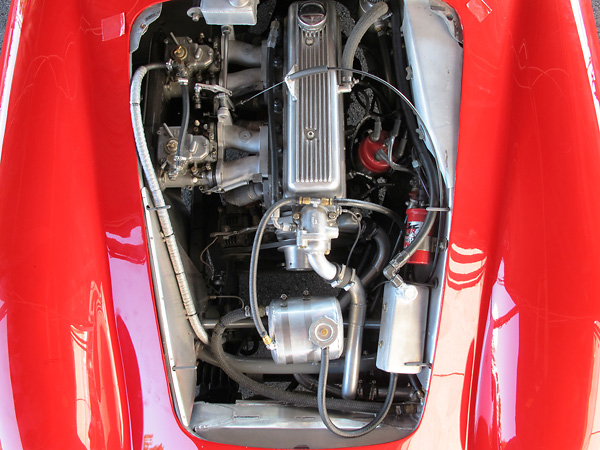
Rebuilt and race prepared Triumph TR3 engine.
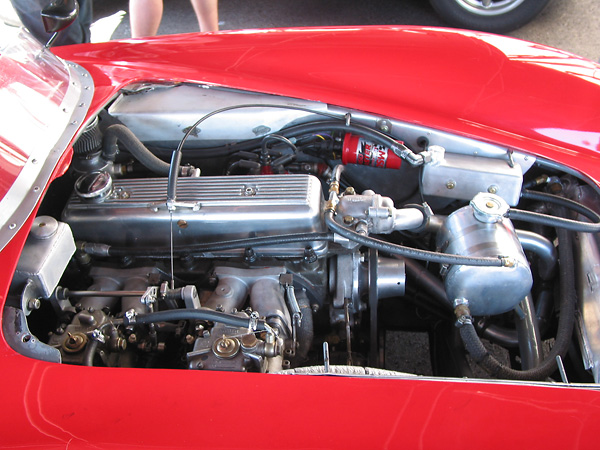
The Triumph TR3 engine has been shifted about five inches rearward relative to the TR3 frame.
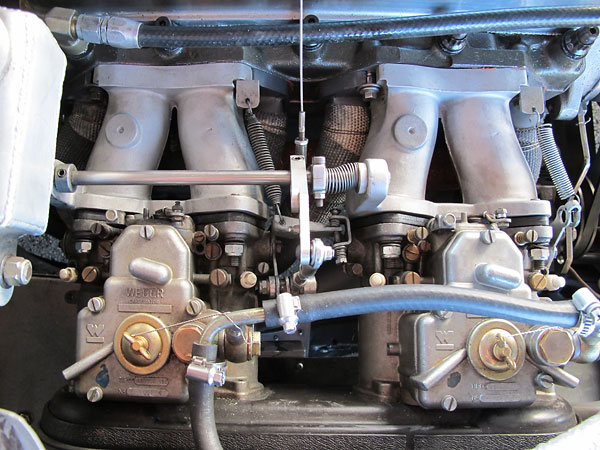
Dual Weber 45DCOE152 carburetors.
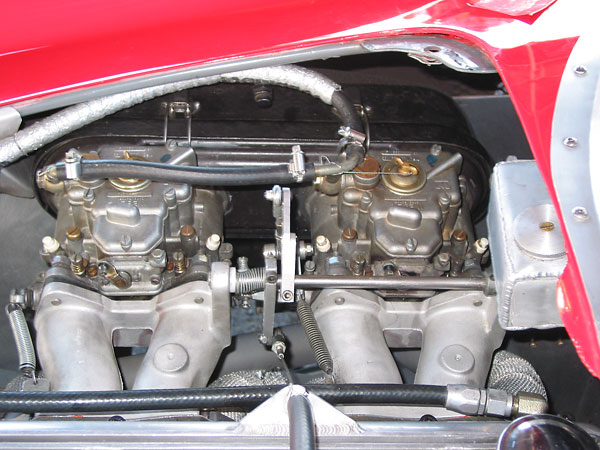
Bill prefers Weber carburetors to the original S.U. units because he feels they're easier to tune.
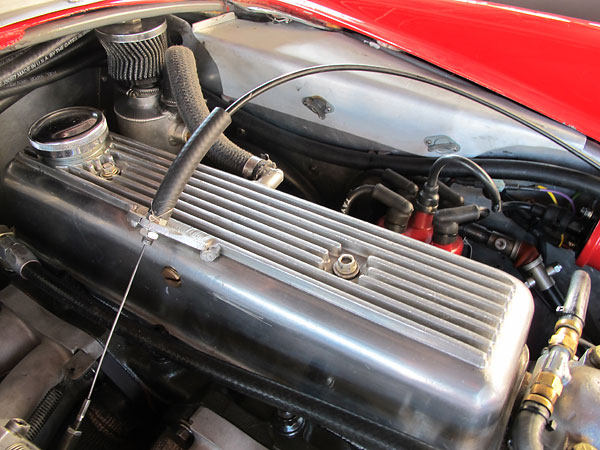
Finned aluminum valve cover.
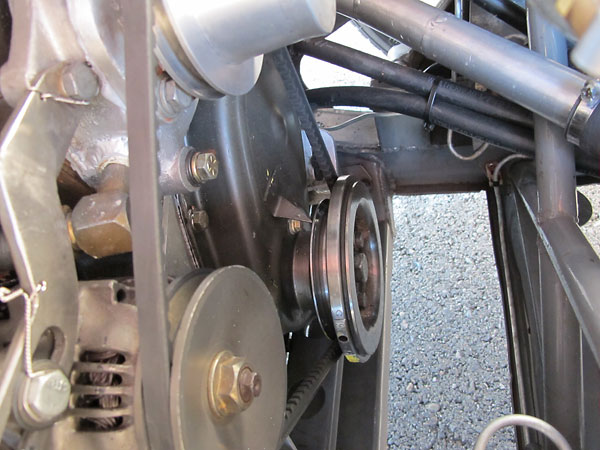
Crankshaft pulley/harmonic balancer has two timing marks: one at 15 degrees and one at 35 degrees.
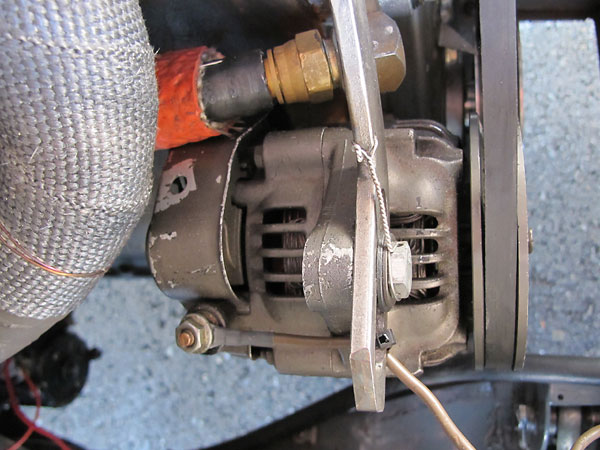
Nippondenso alternator, with oversized pulley.
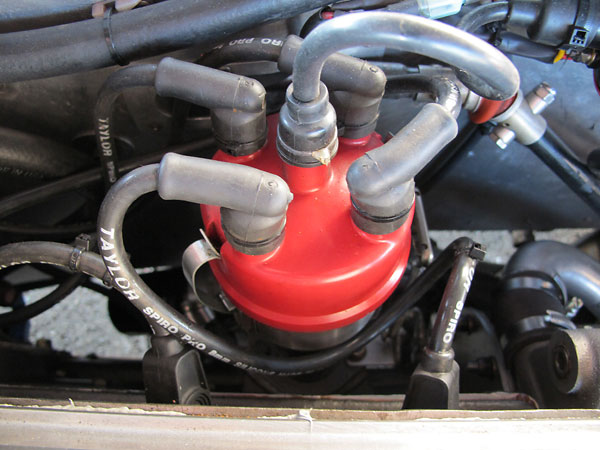
Mallory distributor. Taylor Spiro Pro 8mm silicone spark plug wires.
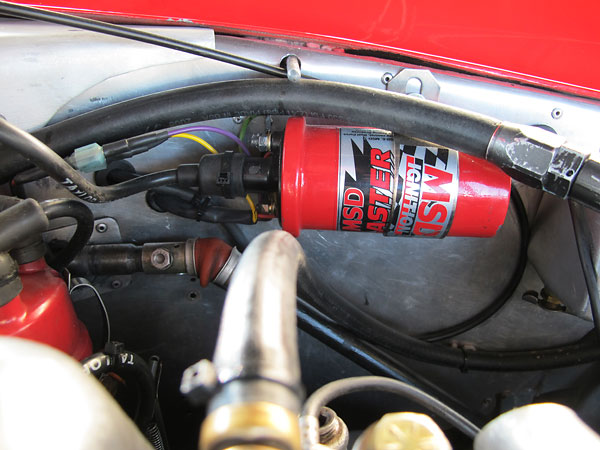
MSD Blaster ignition coil.
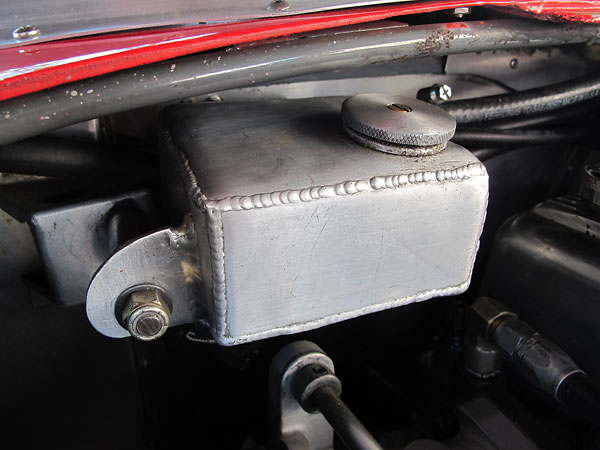
Custom fabricated aluminum brake fluid reservoir.
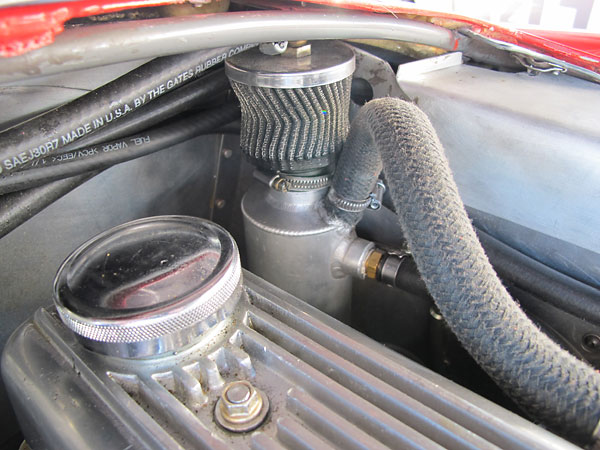
Aluminum crankcase breather tank.
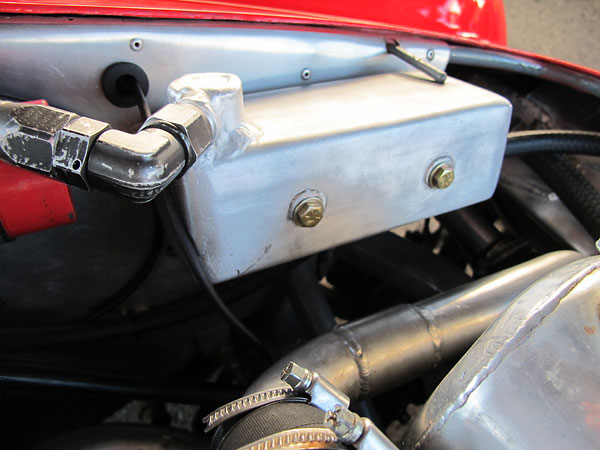
Custom fabricated aluminum coolant overflow catch tank.
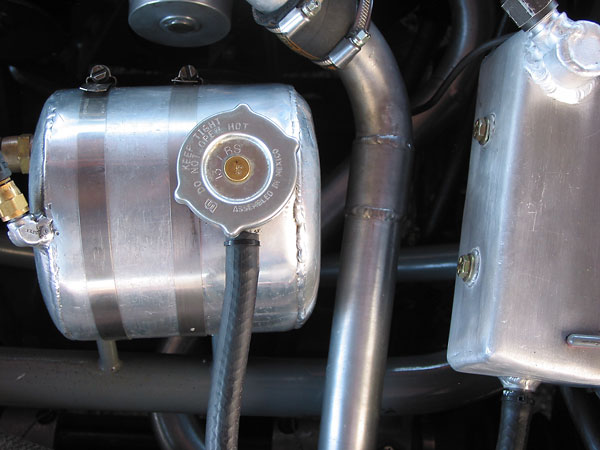
Custom fabricated aluminum coolant header tank, with 13psi pressure cap.
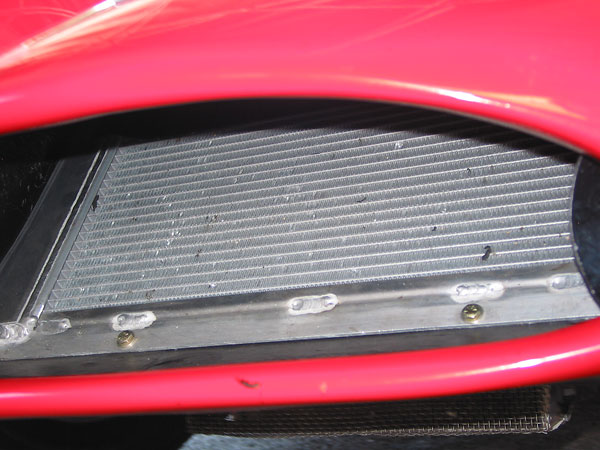
Tony Garmey of Horizon Racing created this radiator by welding two off-the-shelf radiators together.
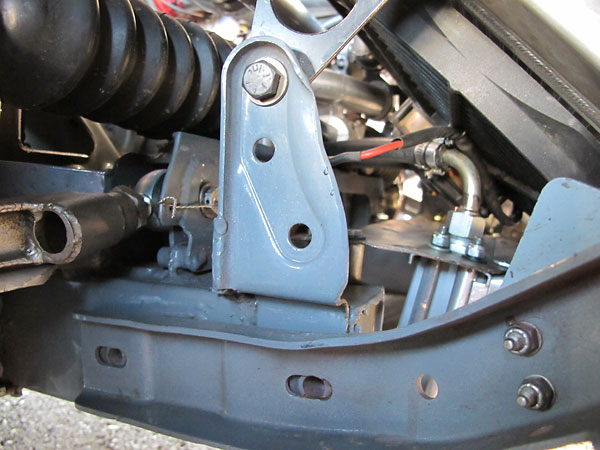
Electric radiator fan.
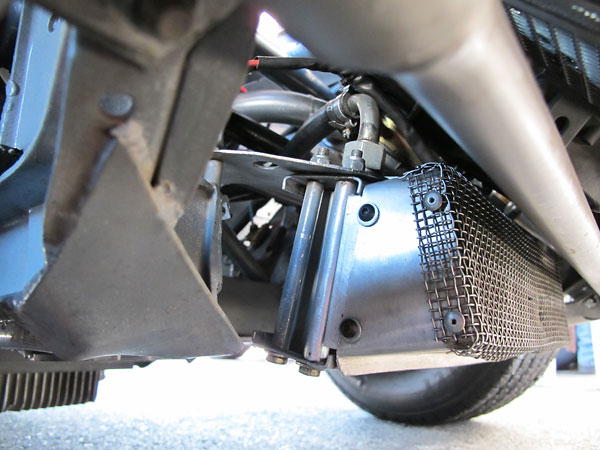
Oil cooler.
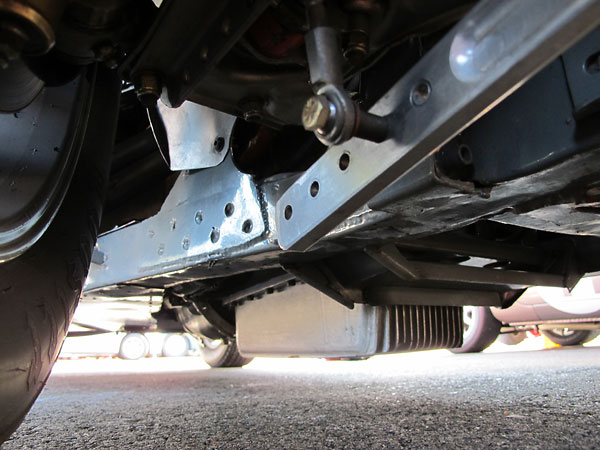
Deep sump finned aluminum oil pan.
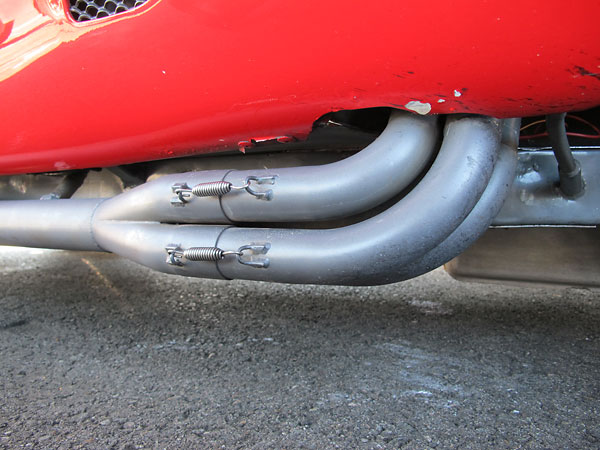
Slipjoints at the header collector.
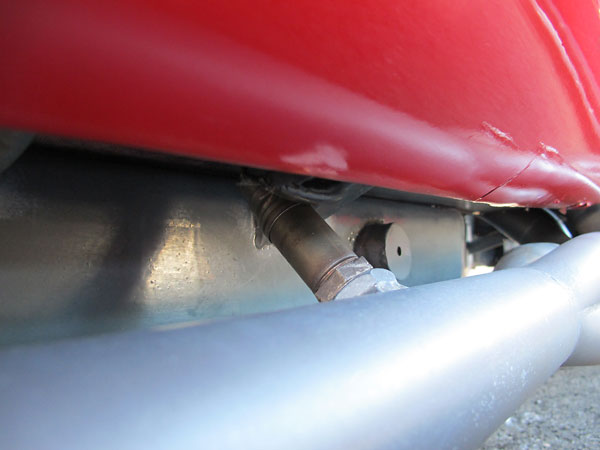
Wideband oxygen sensor.
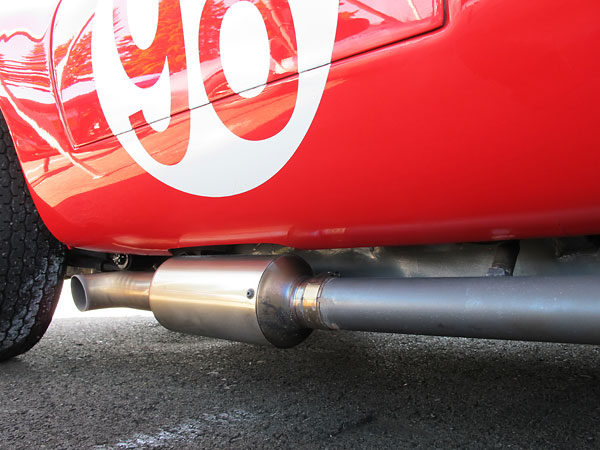
Stainless steel muffler.
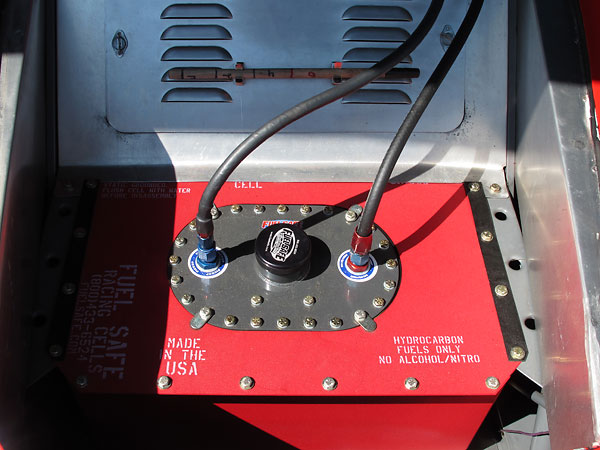
Fuel Safe steel canister fuel cell. Note dipstick for checking fuel level, and service panel for rear end.
Front Suspension
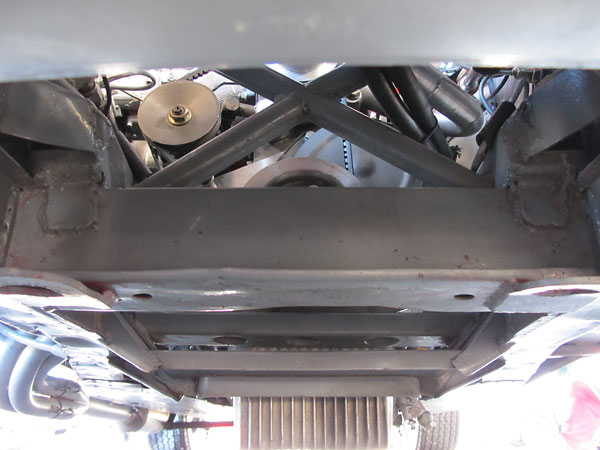
Reinforced Triumph TR3 frame, with crossmember added between front suspension pick-up points.
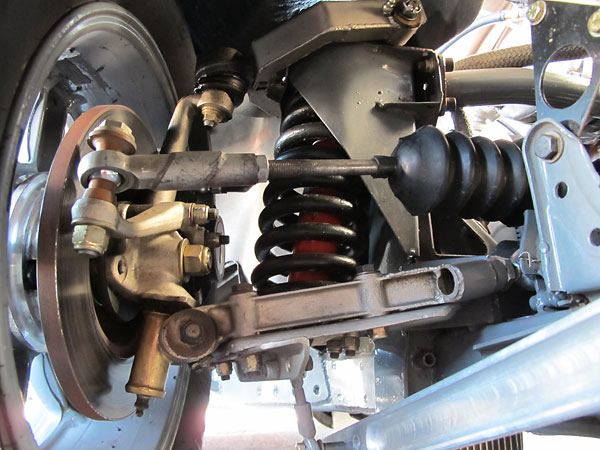
Stock lower control arms modified with Heim joints on inboard side for adjustability.
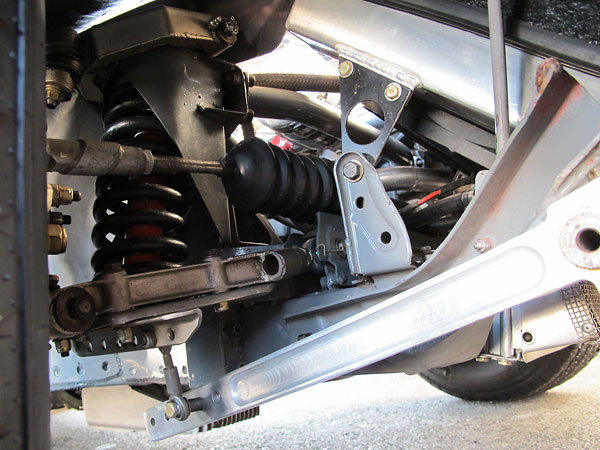
Adjustable (5 position) modular anti-sway bar.
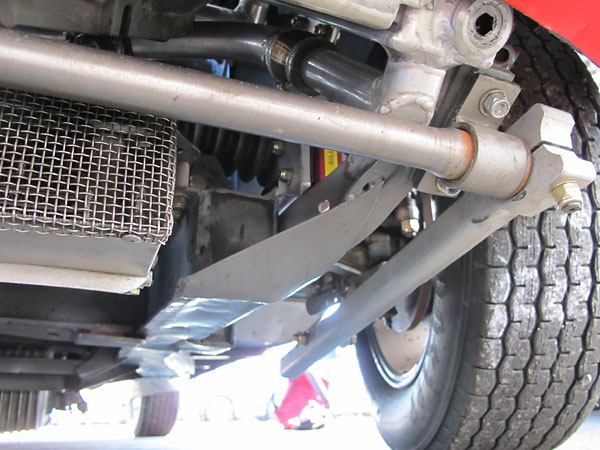
Anti-sway bar mounting brackets.
Enjoying this article? www.BritishRaceCar.com is partially funded through generous support from readers like you!
To contribute to our operating budget, please click here and follow the instructions.
(Suggested contribution is twenty bucks per year. Feel free to give more!)
Rear Suspension
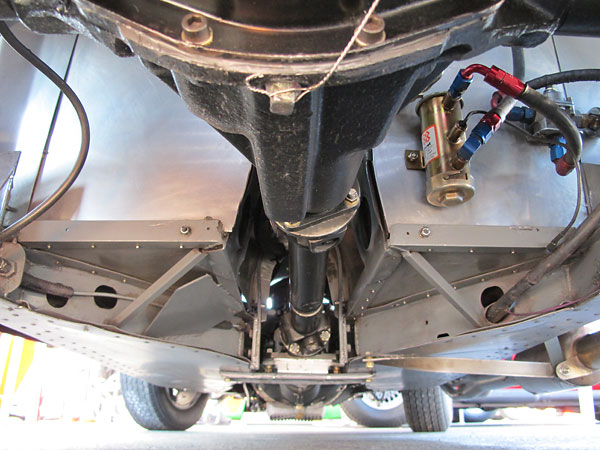
Facet Bendix-style electric fuel pump. Holley adjustable fuel pressure regulator.
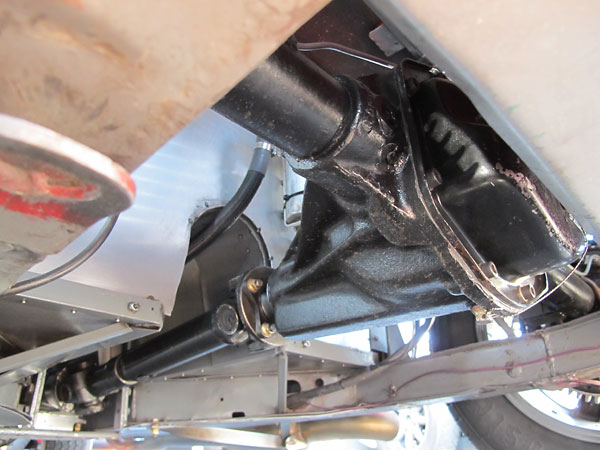
Triumph TR3 housing with Tran-X limited slip differential inside.
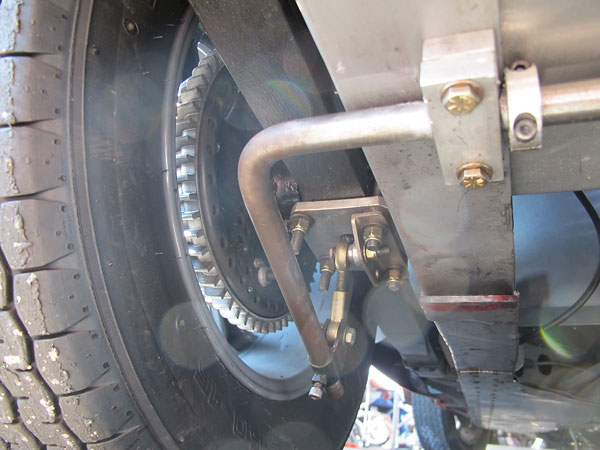
Adjustable anti-sway bar mounted on aluminum pillow blocks.
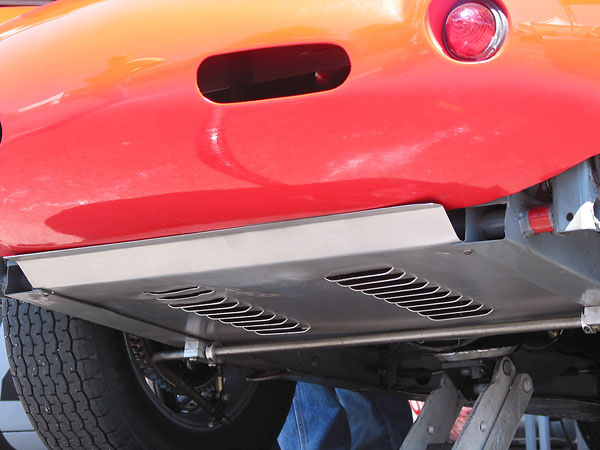
Neat louvered tray under the fuel cell.
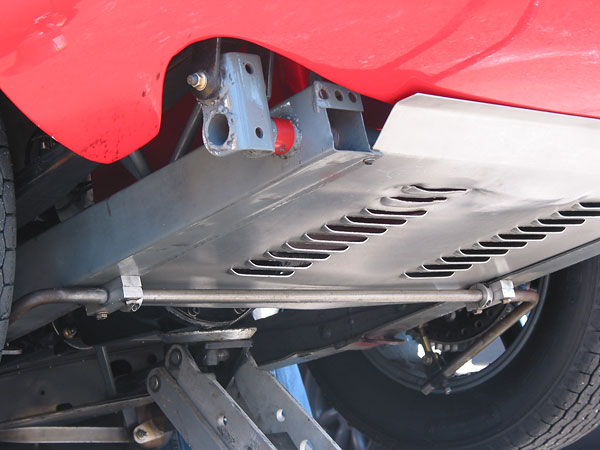
Raised spring shackle mounts.
Interior
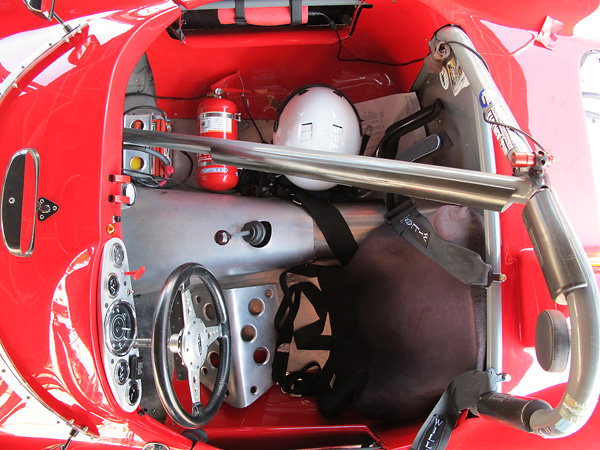
This is the Devin's second cage. Bill had an rollover accident, so Tony replaced the first one.
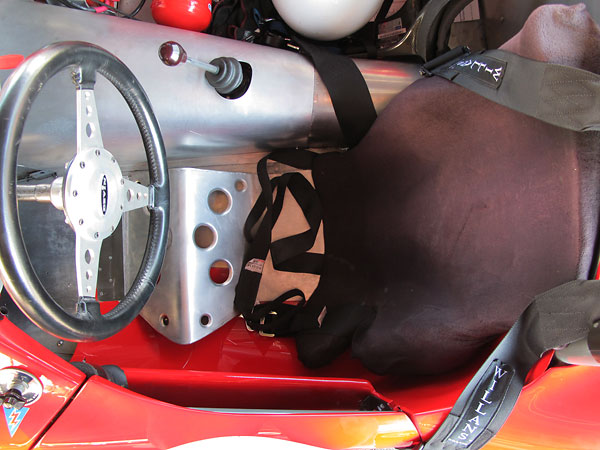
Willans safety harness.
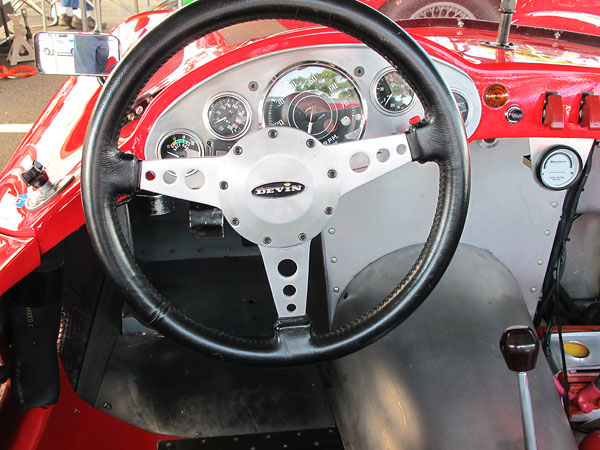
Custom molded seat cushions and Willans safety harness.
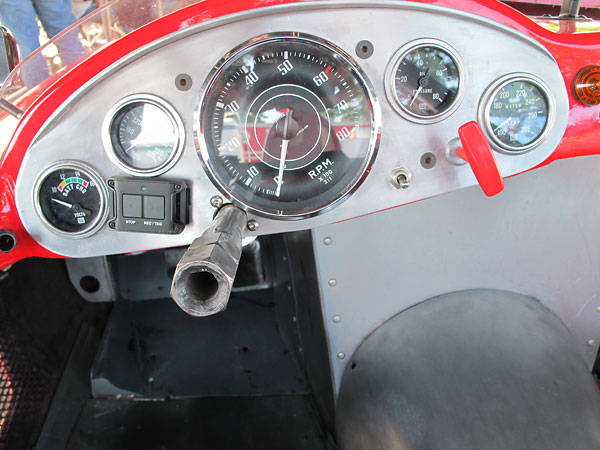
Jaeger tachometer, in combination with Stewart Warner voltmeter, oil temperature gauge,
oil pressure gauge, water temperature gauge, and air/fuel ratio gauge.
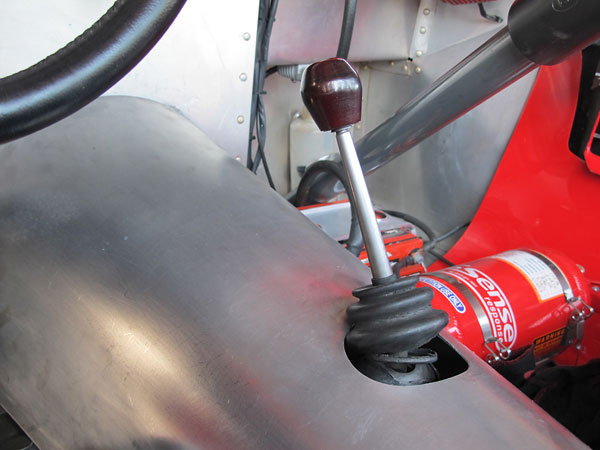
Triumph TR3 shifter lever, rotated 180 degrees for better driver comfort in the Devin cockpit.
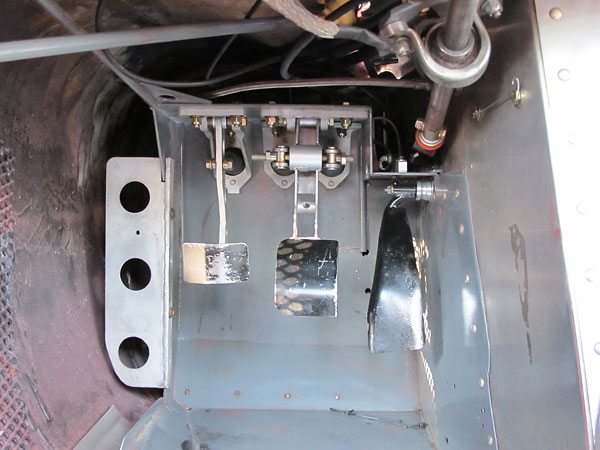
Dual brake master cylinders with adjustable bias bar.
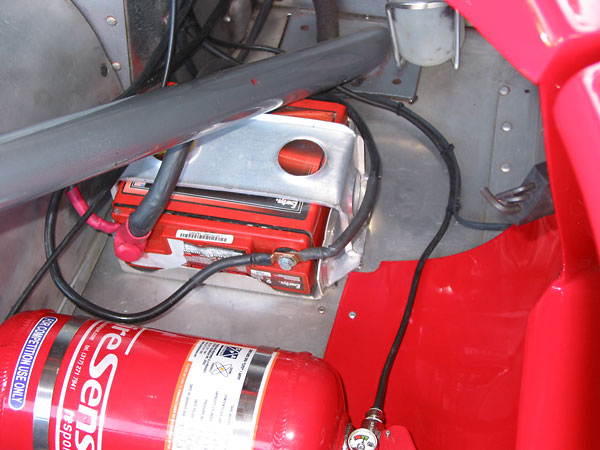
Enersys / Odyssey sealed lead acid battery.
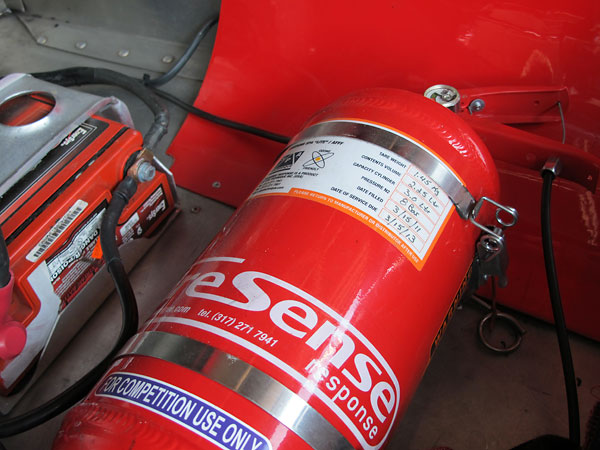
SPA Design FireSense fire suppression system.
Exterior
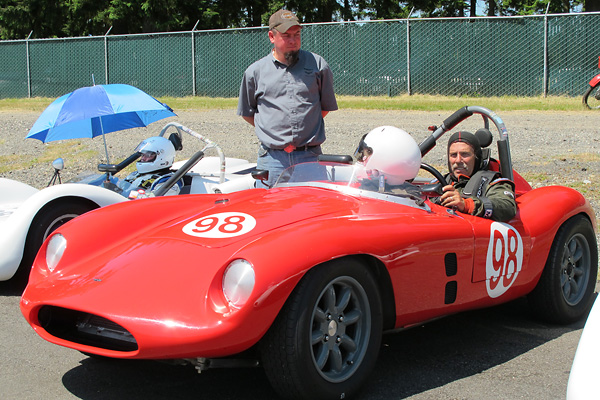
During SOVREN's 2011 Pacific Northwest Historics at Pacific Raceways in Kent Washington,
Bill Hart circled the beautiful 2.25 mile circuit with a best lap time of 1:43.473, which
averages out to 78.28mph.
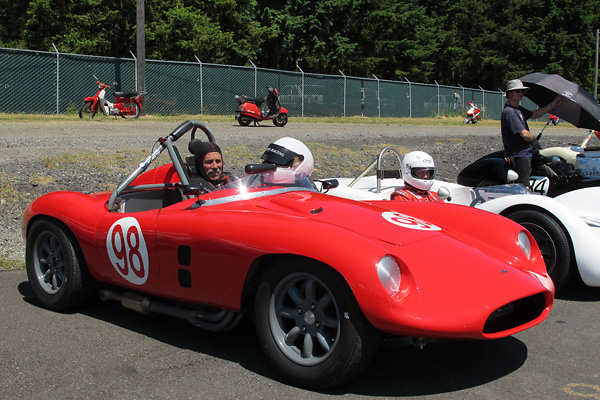
The famous Italian styling house Scaglietti deserves all the credit for Devin's exceptional styling.
Bill Devin borrowed an 1955 Ermini Tipo 357 Sport (body by Scaglietti) and made molds off of it.
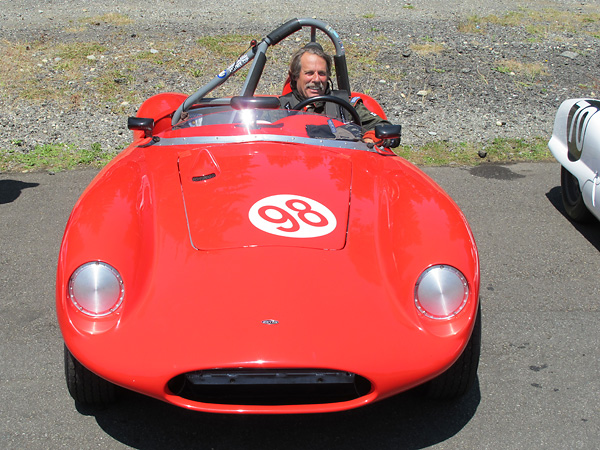
No one enjoys vintage racing more than Bill Hart. Look at that grin!
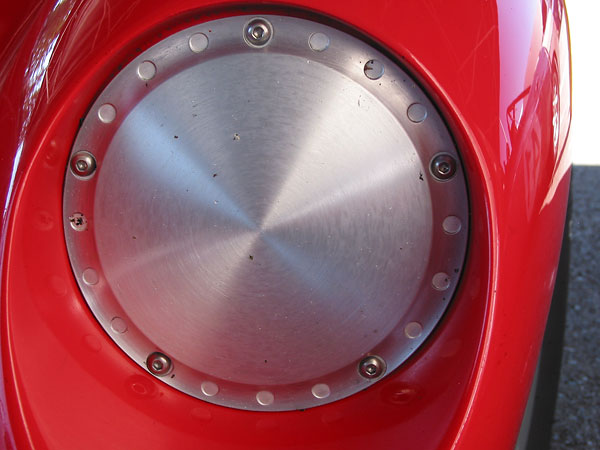
Harley Davidson 5-hole "derby" covers (i.e. clutch housing dust covers) are an attractive and
cost effective alternative to sealed beam headlights or purpose made headlamp bucket covers.
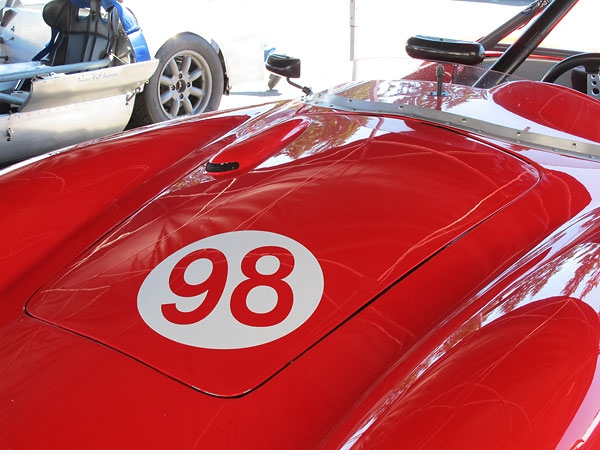
Devin bonnet, with carburetor-side vent added.
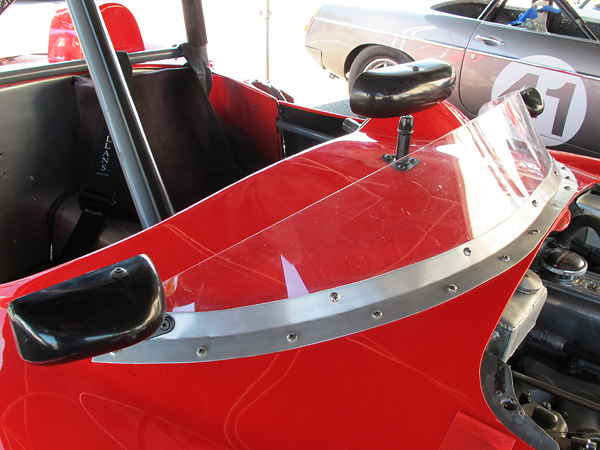
Low profile windscreen. SPA Design rear view mirror.
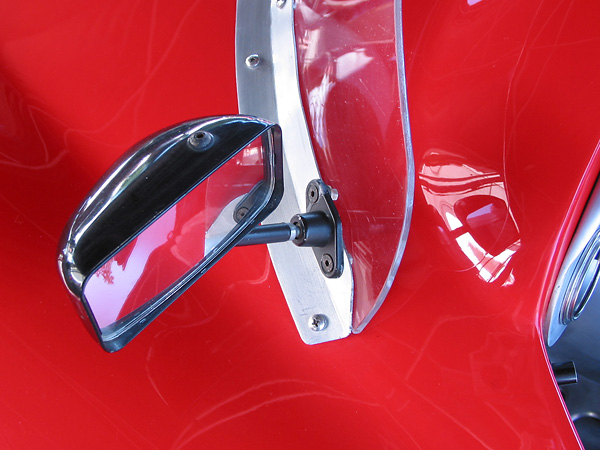
SPA Design side view mirror.
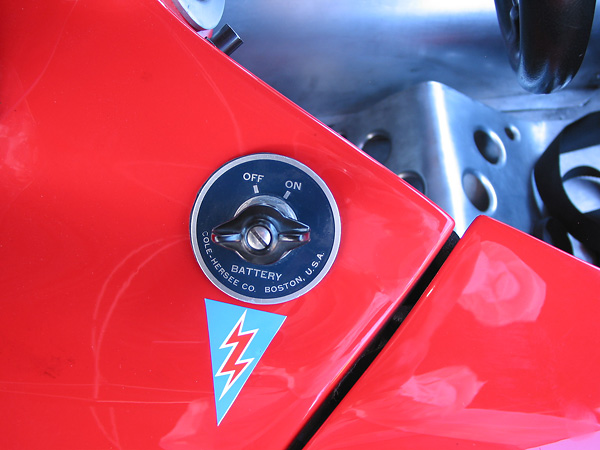
The battery cut-off switch label plate says "Cole-Hersee Co. Boston, U.S.A." but the
knob style indicates that a Lucas battery disconnect switch has been substituted.
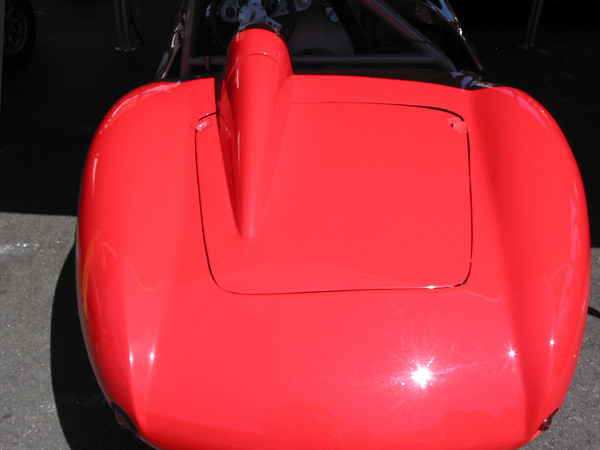
Devin boot lid with molded-in helmet fairing.
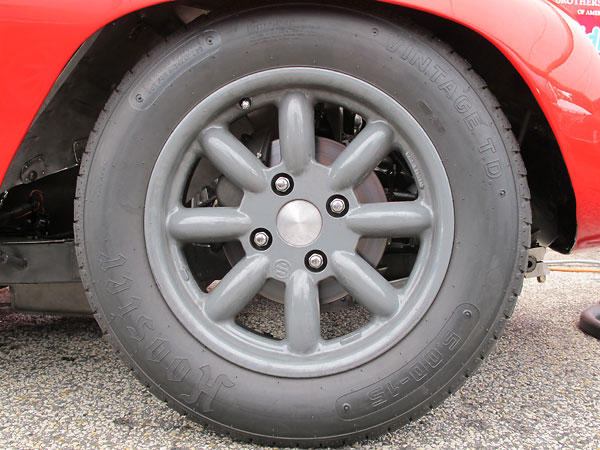
Compomotive ML 8-spoke aluminum wheels.
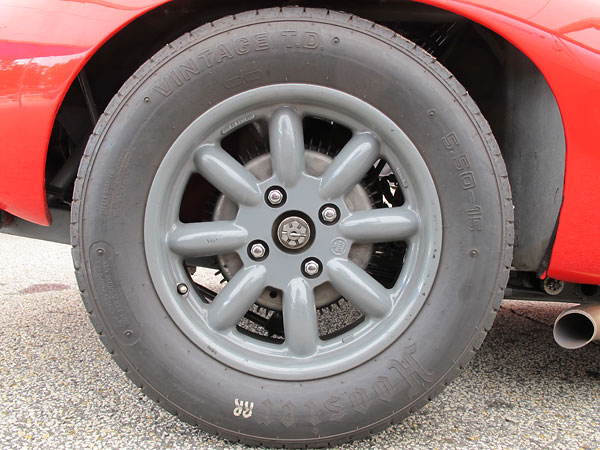
Hoosier Vintage T.D. tires (5.00x15 front, 5.50x15 rear).
| Notes: | ||
| (1) |
Devin ads sometimes included a nifty diagram and a chart to show the body sizes available.
Initially there were twenty-four models, and later they added three larger sizes.
Nominal supported wheelbases were as follows: 78", 80", 82", 84", 86", 88", 90", 92", 94", 96", 98", 100", and 104".
Body width measured at the front fender lips: initially 54", 58", or 62", and later 70".
Body width measured at the rear fender lips: initially 52", 56", or 60", and later 68".
Fiberglass bodies are relatively easy to modify. For example, according to the advertisement
all twenty-seven models came with the same size radiator opening but we know from observation
that some customers enlarged the radiator opening, presumably to increase cooling capacity.
| |
All photos except the last two (tire/wheel photos) are from July 2011 when we viewed the car at
The Pacific Northwest Historics at Pacific Raceways in Kent, Washington. The tire/wheel photos
are from May 2012 when we viewed the car at Road Atlanta during The Mitty.
All photos by Curtis Jacobson and Ryan Thomas for BritishRaceCar.com, copyright 2012.
All rights reserved.
| If you liked this article, you'll probably also enjoy these: | |||||
 |
Bob Wismer Tornado ThunderBolt (~1960) |
 |
George Wright '61 Triumph TR4 |
 |
Bill Hart Triumph TR250K (~1968) |
| You're invited to discuss anything you've seen here on The British Racecar Motorsports Forum! | |||||
Notice: all the articles and almost all the photos on BritishRacecar.com are by Curtis Jacobson.
(Photos that aren't by Curtis are explicitly credited.) Reproduction without prior written permission is prohibited.
Contact us to purchase images or reproduction permission. Higher resolution images are optionally available.




